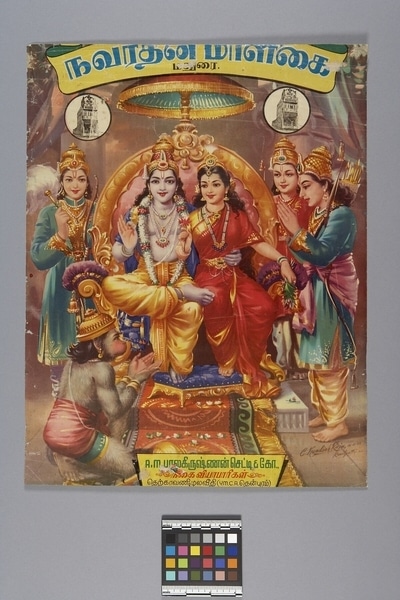Calendar Item Number: Eg163 from the MOA: University of British Columbia

Description
Rectangular shaped calendar print depicting Rama sitting with Sita throne surrounded by adorners. Smiling, blue grey-skinned Rama wearing a floral garland, yellow dhoti and a blue wrap with his arm around the waist of smiling Sita in red sari; both seated on pink-cushioned gold throne with high-arched backrest surmounted by green/red/gold umbrella. Rama has his left hand raised, palm facing out; touches index finger and thumb together. Sita holds red flower in raised right hand. The couple is flanked by four figures, two on each side. Standing behind and at sides of backrest, male on left in green and gold garment is holding a flywhisk and bow. Kneeling in front of Rama is Hannuman wearing a red, green and yellow wrap around his waist. His palms are raised and reaching out. On right, is Lakshmana wearing a green cloak and yellow pants places palms together out in front while facing couple. He carries quiver on back and bow at shoulder. All figures wear gold crowns. Advertisement in yellow bands top and base for 'A.M. BalaKrishnan Chetti & Co.' printed in Indian script. Framed.
History Of Use
Indian popular religious prints have been published for nearly a century, first by German presses, later by Indian ones. The prints may take the form of calendars, posters, or simply images. The style of the representations is European. In the beginning they were Hindu images, but are now acquiring elements both of folk art and a romantic secularism. It is a living art currently influenced by the movie industry and non-Hindu religions. The images are a vehicle for advertising and are also used for religious purposes.
Narrative
Rama, the most perfect of princes, and his noble wife, Sita, portray the ideal couple by their acts of self-denial for the good of society. Popular episode is Rama's rescue of Sita from the ten-headed demon king, Ravana, with the help of Hanuman and Lakshmana.
Cultural Context
calendar art; popular religious art
Iconographic Meaning
Rama, seventh incarnation of Vishnu, is identified by the presence of his ideal, loving wife, Sita, by his side; Vaishnavite 'u' on forehead; bow and arrow-filled quiver symbolizing masculine virtures; green-coloured skin; either dressed as a king or forest dweller; presence of Hanuman, half-human, half-monkey deity, often shown kneeling at Rama's feet; and presence of Rama's brother Lakshmana, also carrying an arrow-filled quiver.
Item History
- Made by C. Kondiahraju (Maker) in India during 1956
- Collected before 1982
- Owned by Stephen Inglis before January 1983
- Received from Stephen Inglis (Donor) during January 1983
What
- Name
- Calendar
- Identification Number
- Eg163
- Type of Item
- calendar
- Overall
- height 46.0 cm, width 35.5 cm
- Frame
- height 65.5 cm, width 45.0 cm, depth 2.0 cm
Who
- Culture
- South India
- Creator
- C. Kondiahraju (Maker)
- Previous Owner
- Stephen Inglis
- Received from
- Stephen Inglis (Donor)
Where
- Holding Institution
- MOA: University of British Columbia
- Made in
- India
When
- Creation Date
- during 1956
- Collection Date
- before 1982
- Ownership Date
- before January 1983
- Acquisition Date
- during January 1983
Other
- Item Classes
- works on paper
- Condition
- fair
- Accession Number
- 0857/0017